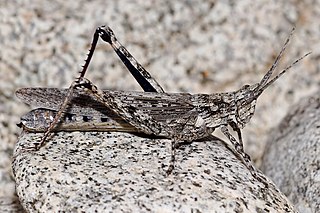
The Acrididae are the predominant family of grasshoppers, comprising some 10,000 of the 11,000 species of the entire suborder Caelifera. The Acrididae are best known because all locusts are of the Acrididae. The subfamily Oedipodinae is sometimes classified as a distinct family Oedipodidae in the superfamily Acridoidea. Acrididae grasshoppers are characterized by relatively short and stout antennae, and tympana on the side of the first abdominal segment.
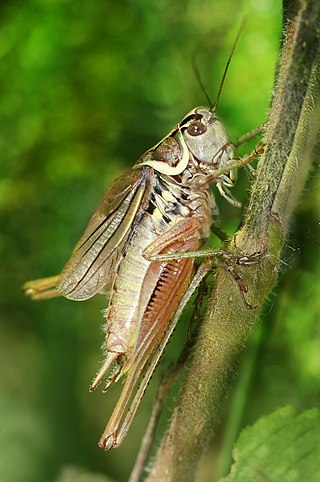
Roesel's bush-cricket, Roeseliana roeselii is a European bush-cricket, named after August Johann Rösel von Rosenhof, a German entomologist.

The speckled bush-cricket is a flightless species of bush-cricket belonging to the family Tettigoniidae. The species was originally described as Locusta punctatissima in 1792.
Schayera baiulus is a species of grasshopper in the family of the Acrididae. The species is endemic to the Northern Region of Tasmania in Australia. The species is extremely rare and critically endangered, with only five confirmed specimens ever found.
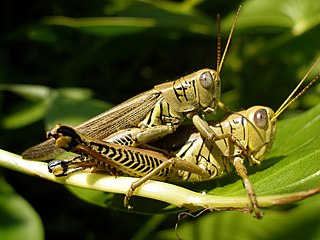
The differential grasshopper is a species of grasshopper belonging to the genus Melanoplus. It is found throughout northern Mexico, the central United States and southern Ontario, Canada. It is considered a pest over most of its range.

Tettigonia viridissima, the great green bush-cricket, is a large species of bush-cricket belonging to the subfamily Tettigoniinae.
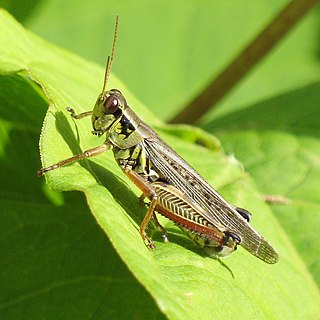
Melanoplus femurrubrum, the red-legged grasshopper, is a species of grasshopper belonging to the genus Melanoplus. It is one of the most common grasshoppers found in Mexico, the United States, and Canada. This grasshopper is frequently used as a model organism in scientific studies, due to their abundance throughout North America and behavioral response to changes in climate.
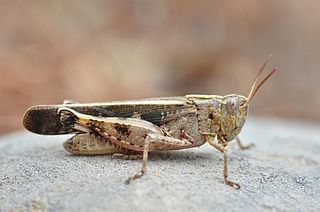
Aiolopus strepens is a species of grasshopper belonging to the family Acrididae, subfamily Oedipodinae.

Anacridium aegyptium, the Egyptian grasshopper or Egyptian locust, is a species of insect belonging to the subfamily Cyrtacanthacridinae.

Calliptamus italicus, the Italian locust, is a species of 'short-horned grasshopper' belonging to the family Acrididae, subfamily Calliptaminae.

Omocestus rufipes, the woodland grasshopper, is a species of short-horned grasshopper belonging to subfamily Gomphocerinae. The Latin species name rufipes means red-footed, from rufus (red) + pes (foot), with reference to the color of the legs.

Podisma pedestris is a species of 'short-horned grasshoppers' belonging to the family Acrididae subfamily Melanoplinae.

Tettigonia cantans is a species of bush crickets belonging to the family Tettigoniidae subfamily Tettigoniinae.

Yersinella raymondi, common name Raymond's Bush-cricket, is a species of "katydids crickets" belonging to the family Tettigoniidae subfamily Tettigoniinae. The scientific name Yersinella comes from the name of the entomologist who has described the species in 1860.

Conocephalus fuscus, the long-winged conehead, is a member of the family Tettigoniidae, the bush-crickets and is distributed through much of Europe and temperate Asia. This bush-cricket is native to the British Isles where it may confused with the short-winged conehead. These two species are phenotypically similar; however, the distinguishing factor between the two is the fully developed set of wings the long-winged conehead possesses that allows for flight. In the short-winged coneheads the hind wings are shorter than the abdomen, causing the wings to be vestigial and the species is incapable of flight. For this reason it is hard to discriminate between the two species during the early stages of their life cycle before the wings have fully developed. The colouration of the conehead is typically a grass green with a distinctive brown stripe down its back, though there are some brown phenotypes.

Oecanthus pellucens, common name Italian tree cricket, is a species of tree crickets belonging to the family Gryllidae, subfamily Oecanthinae.

Anacridium moestum, the camouflaged tree locust, is a species of grasshopper belonging to the family Acrididae, that is native to Africa south of the equator. It is similar in appearance to the Southern African desert locust, Schistocerca gregaria flavicentris. It is likewise brownish, large and slender, but mostly arboreal in its habits.

Pezotettix is a genus of 'short-horned grasshoppers' belonging to the family Acrididae subfamily Pezotettiginae.

Xenocatantops humilis is the type species of grasshoppers in its genus, belonging to the family Acrididae and subfamily Catantopinae.

Eyprepocnemis plorans, the lamenting grasshopper, is a species of insect in the family Acrididae. It is the type species of the genus Eyprepocnemis, and is found in Africa, parts of the Middle East, and southern Europe. It typically inhabits wetlands and other moist habitats.




















